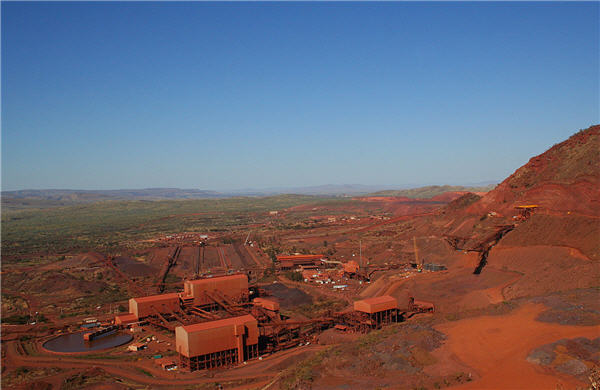Hedge funds bullish gold bets surge to 13.8m ounces |
- Hedge funds bullish gold bets surge to 13.8m ounces
- Tibetans protest land seizure linked to gold mining
- TIL: Alan Greenspan's first job was a metals analyst
- Value of US mineral production decreased in 2013
- 'Inevitable large surplus' to crush iron ore price to double digits
| Hedge funds bullish gold bets surge to 13.8m ounces Posted: 23 Mar 2014 02:10 PM PDT
The gold price ended higher Friday after bullish positions held by large investors soared again. By the close of regular trade on the Comex division of the New York Mercantile Exchange, gold futures for June delivery – the most active contract – rose to $1,335 an ounce but remained sharply off for the week. On Monday the metal hit a high above $1,380, the best level since June and up 14.8% since the start of the year. Long positions – bets that the price will go up – held by so-called managed money increased to 151,939 lots in the week to February 18 according to Commodity Futures Trading Commission data released after the close of business on Friday. At the same time short positions, indicating weaker prices ahead, were cut by 7,563 to just under 13,510, which translates on a net basis hedge funds holding 138,429 lots or 13.8 million ounces, the highest in more than a year. The 12.5% jump was the sixth week in a row that large investors increased bullish positions and more significantly it showed fresh buying, compared to the increases of previous weeks which were to cover short positions. In December 2013 longs fell to a paltry 26,774 lots while shorts held by large investors peaked at more than 80,000 lots, the highest since 2007, back when gold changed hands for $700 an ounce. It's not only gold derivatives that are finding favour from the smart money in 2014. Investors in gold-backed ETFs are also returning to the market in droves after 2013 saw net redemptions of a staggering 800 tonnes. Holdings of SPDR Gold Shares (NYSEARCA: GLD) – the world's largest gold ETF holding more than 40% of the total – on Friday shot up 4.2 tonnes, bringing year to date gains to 18.75 tonnes. While the additions have been fairly modest it is in sharp contrast to last year when GLD recorded only 17 days of inflows over the course of the 12 months and almost 540 tonnes left the fund. In the week to 14 March global gold ETF holdings rose 12.3 tonnes the biggest move since November 2012, taking total holdings to 1766.4 tonnes, the highest level since December 27 and more than 30 tonnes above the lows for the year. Gold bullion holdings in global ETFs hit a record 2,632 tonnes or 93 million ounces in December 2012. Image of traders at Sao Paulo stock exchange by Rafael Matsunaga |
| Tibetans protest land seizure linked to gold mining Posted: 23 Mar 2014 11:33 AM PDT Hundreds of Tibetans last week protested land seizures for the construction of highways linked to the Sangchu gold mining industry in the Kanlho (Gannan) Tibetan Autonomous Prefecture. The protests centre on the confiscation of farm land and pollution brought on by increased Chinese state-backed mining and industrial activity, particularly a new cement factory. Radio Free Asia reports Tibetans opposed to gold mining activities in the Dzo Zekhong area in Sangchu's Tsayue township attacked the authorities for "disregarding Tibetan concerns over the destruction of the environment by the mining and other activities" according to one community activist: There are about 15 Chinese groups extracting gold in Tsayue township and the mining activities have fueled other industrial projects, the Tibetan said. "Multi-story buildings are being erected in the area and the Chinese expansion of activity is in full swing," he said. "They have been digging for gold for years knowing fully well of the Tibetan concerns over its effects on the environment. The Tibetans have appealed to the authorities several times but there has been no positive response," the Tibetan said "Now, more construction is coming up, and new factories are also being built in the area and adversely affecting the local environment, the Tibetan said. A Tibetan man burned himself to death at the entrance to a Chinese mining site in 2012 in the Sangchu county to protest against Beijing's rule, according to RFA. |
| TIL: Alan Greenspan's first job was a metals analyst Posted: 23 Mar 2014 10:06 AM PDT Copper is widely used in the power, telecoms and construction sectors and is often seen as a leading indicator for economic growth. In an excellent piece about how the prognostic abilities of copper has diminished, Bloomberg tapped one of the sages (or villians) of the financial world for his views. Alan Greenspan, who was Chairman of the US Federal Reserve for the better part of two decades, also revealed that his very first job was as a metals analysts and that he still follows metals price daily: "Shifts in the economy's makeup have reduced the role of industrial commodities, including copper, as indicators of growth and inflation, according to Greenspan, 88, who was Fed chairman from 1987 to 2006. Services account for 87 percent of U.S. economic output, compared with 72 percent in the early 1950s, shrinking the share of manufacturing to less than 13 percent from 28 percent, Commerce Department data show. "In the 1950s and 1960s, when timely data on industrial trends were lacking, I found copper prices a very useful proxy," Greenspan, whose first job in 1948 was analyzing metals demand for the National Industrial Conference Board, said by e-mail. "That, of course, is less so today. But I still cannot resist checking prices on both the London Metal Exchange and Comex on a daily basis." *TIL: Web acronym for Today I Learned. Image of Alan Greenspan in 2011 by FT |
| Value of US mineral production decreased in 2013 Posted: 23 Mar 2014 08:08 AM PDT After three consecutive years of increases, the value of US mineral production declined last year. According to the US Geological Survey's Mineral Commodity Summaries 2014 report, the US produced $74.3 billion worth of minerals in 2013, down slightly from $75.8 billion in 2012. Net exports of mineral raw materials and old scrap contributed an additional $15.8 billion to the US economy, USGS wrote. "To put this in context, the $90.1 billion value of combined mined, exported, and recycled raw materials is more than five times greater than the 2013 combined net revenues of Internet titans: Amazon, Facebook, Google, and Yahoo," USGS Mineral Resources Program Coordinator Larry Meinert said in a statement. "This illustrates the fundamental importance of mineral resources to the nation's economy, technology, and national security." This report, which the USGS produces each year, includes statistics on 90 mineral commodities. The drop in value was not due to lower production – in fact, production increased for most industrial mineral commodities and remained stable for most metals (though domestic gold production declined by 3%). Rather, a drop in metals prices resulted in the reduced overall value of US mineral production. Production from US metal mines resulted in an estimated value of $32 billion – an 8% decrease on the year before. Gold contributed 32% of that value and copper 29%. "Minerals remain fundamental to the U.S. economy, contributing to the real gross domestic product at several levels, including mining, processing, and manufacturing finished products," the USGS wrote. "The U.S. continues to rely on foreign sources for raw and processed mineral materials." Employment in the mining sector The Mineral Commodity Summaries 2014 also provides statistics on employment in the mineral industry. The number of production workers in coal mining dropped from 76,000 in 2012 to 73,000 last year. Meanwhile, employment in the metal mining sector has sky-rocketed over the past five years. In 2009 there were 28,000 production workers in metal mining. Last year there were 105,000 – a 2,000-person increase on the year before. |
| 'Inevitable large surplus' to crush iron ore price to double digits Posted: 23 Mar 2014 03:18 AM PDT According to data from the The Steel Index, the import price of 62% iron ore fines at China's Tianjin port ended Friday at $110.70 per tonne where it was trading for most of the week. Iron ore is down 17.5% since the start of the year as China's economy and particularly its steel industry enters a period of slowing growth. While demand is picking up in Europe and elsewhere, iron ore is highly exposed to China which accounts for nearly 75% of global usage, 62% of global trade of roughly 1.3 billion tonnes and around 48% of global steel output. Iron ore was one of the better performing commodities last year averaging $135 a tonne thanks to record breaking imports by China fueled by mills restocking. Regulation changes in July facilitated the use of ore as collateral for loans creating fresh demand for the commodity. About 40% of the more than 100m tonnes of iron ore at China's ports are part of finance deals according to some estimates. Independent research house Capital Economics in a new study predicts further downside for the iron ore price. Capital Economics Senior Commodities Economist Caroline Bain was one of the more bullish forecasters, predicting iron ore to retreat to $110 by the end of the year, but has now slashed the end-2014 price to $95 and to $85 the following year. Apart from Chinese economic woes a number of factors industry-specific factors will results in a decline in the price says Capital Economics:
Capital Economics says the inevitable slump in the price "begs the question of why the mining companies have maintained their commitment to higher production." The answer is that the new supply is generally very low cost with Brazil's Vale enjoying all in costs of below $50 a tonne while Anglo-Australian giants can produce for as little as $40 – $45 a tonne. With costs of around $110, smaller producers inside China will find it tough going and will be forced out of the market. Image of Rio Tinto's Mount Tom Price mine in the Pilbara from Wikimedia Commons |
| You are subscribed to email updates from MINING.com To stop receiving these emails, you may unsubscribe now. | Email delivery powered by Google |
| Google Inc., 20 West Kinzie, Chicago IL USA 60610 | |


0 Comment for "Hedge funds bullish gold bets surge to 13.8m ounces"